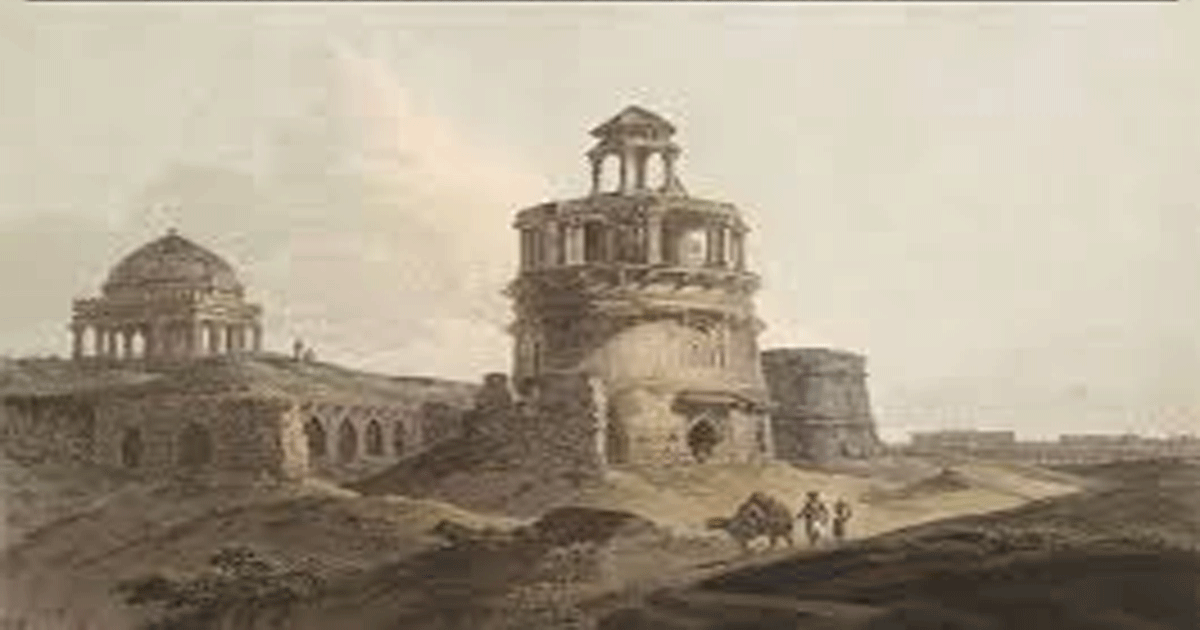National News
Now Firoz Shah Fort and Chor Kuan will be made encroachment free in Sambhal, know the action of DM-SP

Sambhal: The work on the plan to preserve the heritage sites of ancient and religious importance by the administration in Sambhal, Uttar Pradesh has intensified. After the violence that broke out during the Shahi Jama Masjid survey on November 24, the administrative team is continuously engaged in identifying such sites. Excavations have been done at many places in Sambhal. A large number of sites of historical and religious importance have been found in it. After finding a historical stepwell in Mohalla Laxman Ganj, a plan has been prepared to free Firozshah Fort and Chor Kuan from encroachment. Sambhal DM Dr. Rajendra Pansiya and SP KK Vishnoi inspected Firozshah Fort, Kshemnath Tirtha Neemsar, Tota-Maina’s grave and Rajput era stepwell Chor Kuan on Wednesday.
Sambhal was called Kalki city
Sambhal DM Rajendra Pansia said about Sambhal that it is called the city of tomorrow i.e. Kalki Nagari. He clearly said that if we do not preserve history, it will leave us. Both the officers first inspected the Firoz Shah Fort. It is a building protected by ASI. It was constructed between the years 1656 and 1659.
The problem of encroachment has become severe in this fort spread over 1.2 hectares. The main signboard has been closed with a boundary wall by making illegal construction at the entry gate of the fort. The DM expressed displeasure over this. He ordered to demolish the kutcha wall immediately.
questions raised on negligence
During the inspection, the DM also raised questions on the negligence of the Archaeological Department and ordered action. Along with this, the DM instructed the Lekhpals to measure the protected land of the fort. He also issued instructions to the Pradhan to clean the well built near the fort. The DM also saw the tunnel built in the fort and the room of Chand Suraj. Both the officers instructed the officials to preserve them and make the area encroachment free.
Inspection of Kshemanath shrine
After this, the DM inspected Kshemnath Teerth Neemsar. There, after 40 years, the renovation work of the awakened well has started. Seeing the 10 to 12 feet deep water, the DM called it an awakened well. It is very important from the religious and water conservation point of view. After this, the DM and SP also inspected the grave of Tota-Maina and the Rajput era stepwell Chor Kuan.
Why was it named Chor Kuan?
The DM saw the unique architecture and secret rooms of the stepwell. He called it a historical heritage. He expressed surprise and asked why the Rajput stepwell was named Chor Kuan? The DM said that the name and glorious history of this stepwell will be brought back. He said that its excavation will be done under the supervision of the State Archaeological Department and ASI.
The DM said that it will be freed from encroachment and given the status of protected heritage. It is being claimed about this stepwell that it was built during the reign of Rajput ruler Prithviraj Chauhan.
The fort is 356 years old
Sambhal’s Firoz Shah Fort is a repository of ancient heritage. It is a glorious symbol of the Mughal era. Firoz Shah Fort is famous for its historicity and grandeur. This fort is located about five kilometers from Sambhal on the banks of the Sot River. It was constructed between 1656 and 1659 on the orders of Mughal emperor Shah Jahan for his chief courtier Syed Firoz.
To strengthen his hold on his throne in Delhi, Shah Jahan handed over the estate of Sambhal to Syed Firoz. Chand Mahal and Suraj Mahal were constructed in this fort. Its beauty presents an excellent example of Mughal architecture. This fort has turned into ruins at present.
National News
Housing fraud case: Ajit Pawar accepts NCP minister Manikrao Kokate’s resignation, forwards it to CM

Mumbai, Dec 18: Amid a chorus from the opposition, Maharashtra Deputy Chief Minister and NCP chief Ajit Pawar on Thursday accepted the resignation of party minister Manikrao Kokate, against whom an arrest warrant has been issued in a housing fraud case.
Kokate had submitted his resignation to DCM Pawar on Wednesday after a sessions court sentenced him to two years’ imprisonment in the Nashik housing fraud case.
On Wednesday night, Kokate was stripped of his Sports and Minority Affairs portfolios and was retained as a minister without any portfolio.
Kokate is currently undergoing medical examination at Lilavati Hospital after he complained of uneasiness. He has already approached the Bombay High Court seeking relief from the sessions court ruling.
In a post on X, Ajit Pawar said: “Maharashtra Cabinet Minister and my party colleague Shri Manikrao Kokate has submitted his resignation to me following the outcome of the Hon’ble Court’s verdict. In keeping with our party’s long-standing philosophy that the rule of law is supreme and above all individuals, the resignation has been accepted in principle. I have forwarded Shri Kokate’s resignation to the Hon’ble Chief Minister for due consideration and acceptance, in accordance with constitutional procedure.”
He further stated: “Our party has always believed that public life must be guided by constitutional morality, institutional integrity and respect for the judiciary. We stand firmly by the rule of law and will continue to act in a manner that upholds democratic values and public trust.”
Pawar took the decision after holding a meeting lasting over two-and-a-half hours early Thursday morning with party working president Praful Patel and state chief Sunil Tatkare.
Manikrao Kokate is a five-time MLA from the Sinnar constituency in Nashik district and has a history of shifting political loyalties. His membership of the legislature could also be at risk if the High Court upholds the sessions court ruling.
The sessions court upheld his conviction in a case involving the illegal acquisition of government flats through forged documents and sentenced him to two years of imprisonment. Following the verdict, an arrest warrant was issued against Kokate.
He faces imminent arrest unless the High Court grants a stay on the conviction.
Amid these legal developments, Kokate’s health condition deteriorated and he was admitted to Lilavati Hospital in Mumbai. He skipped the weekly cabinet meeting held on Wednesday at Mantralaya.
Kokate’s legal team informed the court that he was admitted to a hospital and sought a four-day stay on the arrest. However, the court rejected the plea, noting that no medical certificate was presented and that Kokate should have been present when the verdict was delivered.
Kokate has moved the Mumbai High Court challenging the sessions court ruling and has sought an urgent hearing and a stay on the sentence.
The High Court is scheduled to hear the matter on Friday.
The case dates back to 1995 and involves the alleged misappropriation of flats reserved under the Chief Minister’s quota. These flats are meant for low-income individuals who do not own property elsewhere.
Manikrao Kokate and his brother Vijay Kokate were accused of submitting fraudulent affidavits and documents to acquire two flats in the Nirman View Apartment in Nashik.
Investigations later revealed that the brothers were also using two additional flats in the same building that had been allotted to other beneficiaries.
Based on an inquiry conducted by the district administration, Vishwanath Patil, then an official of the Urban Land Ceiling (ULC) department, filed a complaint. Subsequently, a fraud case was registered at Sarkarwada Police Station against four individuals, including the Kokate brothers.
The court sentenced them to two years of rigorous imprisonment and imposed a fine of Rs 50,000 each.
Since his induction into the cabinet, Kokate has been embroiled in several controversies.
He was stripped of the Agriculture portfolio after the monsoon session of the state legislature in July, following allegations by NCP-SP legislator Rohit Pawar that Kokate was playing games on his mobile phone during a Legislative Council session. While Kokate denied the allegation, it drew widespread criticism.
He also triggered outrage with controversial remarks on farmers, stating: “Even a beggar does not accept one rupee, but here we provide crop insurance for just one rupee, yet some people try to take undue advantage of it.”
During a municipal election campaign, Kokate had also taken a swipe at coalition partner BJP, calling it a “corrupt party” (batlela paksha) that survives by breaking other parties while sidelining its own workers.
Earlier this year, another NCP minister, Dhananjay Munde, had resigned after his aide Walmik Karad was linked to the murder of Santosh Deshmukh, sarpanch of Massajog village in Beed district.
Mumbai Press Exclusive News
2 MD vendors in Mumbai sentenced to 20 years, accused sentenced due to improvement in police investigation in ANC case

The Mumbai Anti-Narcotics Cell had arrested two drug peddlers in 2017 and recovered drugs from their possession and now the court has sentenced these drug peddlers to 20 years in prison and a fine of Rs 1 lakh. Drug peddlers Praveen Dilip Vaghela and Ramdas Pandurang were arrested by ANC’s Ghatkopar and the MD’s car was also seized during the search of the accused.
Crime
Navi Mumbai Police Seize Drugs Worth Rs 21 Lakh, Nigerian National Arrested

The Navi Mumbai Police have seized drugs worth over Rs 21 lakh, including mephedrone and MDMA, and arrested a Nigerian national in connection with the case, officials said on Wednesday.
The seizure followed a routine police patrol carried out on December 15 along Palm Beach Road. A team noticed a foreign national standing suspiciously near a parked scooter late at night. When the police approached him for questioning, the man abandoned the vehicle and fled the spot, raising further suspicion.
Upon checking the scooter, the police recovered 70 grams of mephedrone powder, estimated to be worth nearly Rs 17 lakh. In addition, 120 MDMA tablets were also found during the initial search, an official release stated.
Following the recovery, police launched a search operation to trace the suspect. He was later arrested from his residence in Koparkhairane. During a subsequent search of the premises, police recovered additional quantities of drugs, including mephedrone powder worth around Rs 4 lakh and 40 purple MDMA tablets.
While the combined value of the seized mephedrone powder has been estimated at over Rs 21 lakh, the police did not specify the market value of the MDMA tablets recovered during the operation.
The accused has been identified as Aniehe Kingsley Chinedu, also known as Aney Kingsley Chinedu. He is a Nigerian national and has been booked under relevant sections of the Narcotic Drugs and Psychotropic Substances Act.
Police officials said further investigations are underway to determine the source of the drugs and to identify possible links to a larger drug supply network operating in the region. Authorities are also examining whether the accused was involved in drug distribution across Navi Mumbai and neighbouring areas.
The Navi Mumbai Police said such operations would continue as part of ongoing efforts to curb drug trafficking and ensure public safety.
-

 Crime3 years ago
Crime3 years agoClass 10 student jumps to death in Jaipur
-

 Maharashtra1 year ago
Maharashtra1 year agoMumbai Local Train Update: Central Railway’s New Timetable Comes Into Effect; Check Full List Of Revised Timings & Stations
-

 Maharashtra1 year ago
Maharashtra1 year agoMumbai To Go Toll-Free Tonight! Maharashtra Govt Announces Complete Toll Waiver For Light Motor Vehicles At All 5 Entry Points Of City
-

 Maharashtra1 year ago
Maharashtra1 year agoFalse photo of Imtiaz Jaleel’s rally, exposing the fooling conspiracy
-

 National News1 year ago
National News1 year agoMinistry of Railways rolls out Special Drive 4.0 with focus on digitisation, cleanliness, inclusiveness and grievance redressal
-

 Maharashtra1 year ago
Maharashtra1 year agoMaharashtra Elections 2024: Mumbai Metro & BEST Services Extended Till Midnight On Voting Day
-

 National News1 year ago
National News1 year agoJ&K: 4 Jawans Killed, 28 Injured After Bus Carrying BSF Personnel For Poll Duty Falls Into Gorge In Budgam; Terrifying Visuals Surface
-

 Crime1 year ago
Crime1 year agoBaba Siddique Murder: Mumbai Police Unable To Get Lawrence Bishnoi Custody Due To Home Ministry Order, Says Report












